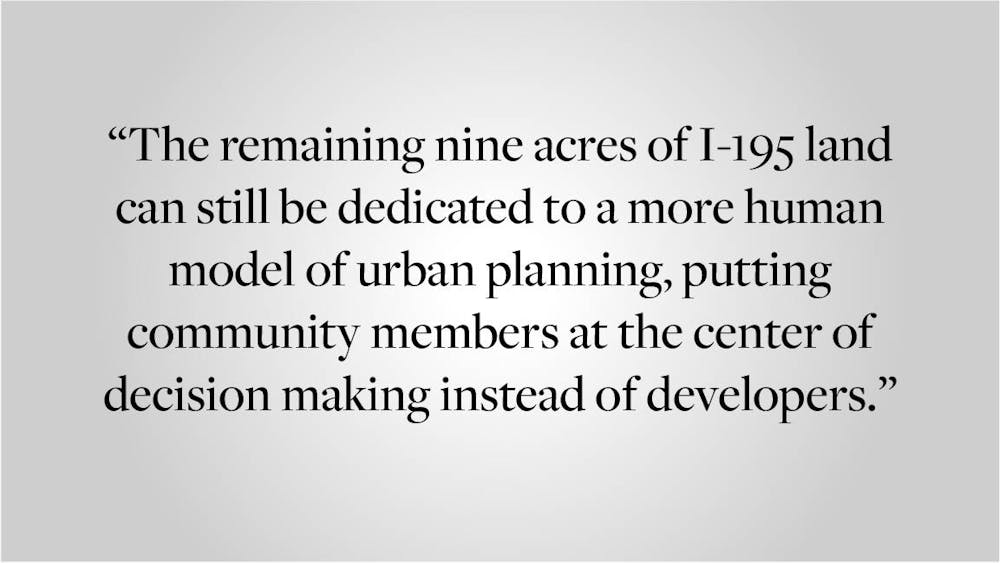In 2011, Providence took a major step in redressing the damages wrought by highway construction by relocating a portion of Interstate 195 so that it circles around downtown rather than cutting through it. This opened 26 acres of prime downtown real estate for development and productive uses, such as housing, commercial space and cultural venues. The job of distributing this lucrative land was given to the state-appointed I-195 Redevelopment District Commission. Though the group has done some good since its inception, recent shortcomings have proved that its useful life has passed. After repeatedly failing the community, the I-195 Commission should step aside and be replaced by a community development corporation, putting residents in charge of the remaining land.
The I-195 Commission started off strong when it got off the ground. Early on, the committee set aside seven acres for open space, which is today the Innovation District Park and contains a pedestrian bridge. Since then, another 10 acres have been redeveloped into apartments, a hotel and office space. Residents in the affected communities of Fox Point and the Jewelry District have complained that the developments do not match the surrounding community and are unimpressive. Most controversial, though, has been the committee’s support of the Hope Point Tower, frequently referred to as “Fane Tower” after its wealthy backer, New York developer Jason Fane. If built, it would be the tallest building in Rhode Island, but it has received serious criticism from many different corners. Residents have claimed that it will stand out horribly in the historic Jewelry District and that the committee is naively continuing to work with the developer despite lengthy delays. To some residents, it is clear that the I-195 Commission does not have the interests of the community at heart and is instead serving the interests of wealthy developers. All is not lost, as the remaining nine acres of I-195 land can still be dedicated to a more human model of urban planning, putting community members at the center of decision making instead of developers.
That said, the commission, as currently structured, is not capable of successfully pivoting to a new development model. In particular, the lack of regard the I-195 Commission has for the community is obvious and unacceptable. By nature, the committee was not designed to accommodate public input. The committee currently meets once a month publicly at 5 p.m. on Zoom. This is a deeply problematic practice for a number of reasons, though one that is certainly not unique to the I-195 Commission. Firstly, a once-a-month meeting seems insufficient for accurately gauging community input on various development proposals, especially when there have already been vocal objectors in the community. Secondly, 5 p.m. is a particularly poor time to hold a community meeting. This is during rush hour, when many people are just getting off of work, or when others are sitting down for dinner, picking up children or running other errands. Placing a community meeting at 5 p.m. then excludes a vast number of residents from having a chance to contribute to the discussion, allowing only those with significant free time to do so. It is important to note that these practices are seen across public-facing planning groups from Denver to British Columbia. It is precisely because these practices are so common that many believe the entire planning process is exclusionary.
Further, these meetings hardly provide any opportunity for community members to speak, demonstrating only a facade of caring for the community. Public comment in every recent meeting of the I-195 Commission has been limited to 15 minutes total. Each member of the community is allowed to speak for three minutes at most, and they only have the opportunity to do so if they email the committee in advance. This callousness is in sharp contrast with willingness the commission has shown to accommodate developers. In the case of Fane Tower, the committee has extended multiple deadlines for the developer after numerous delays. So, while the committee is happy to make exceptions and concessions to wealthy developers, they are unwilling to facilitate adequate community input. It is no wonder then that some in the community have been unsatisfied with the uninspired developments in their area. If community concerns are not addressed, even would-be uncontroversial developments are guaranteed to draw ire, as public officials have violated their fundamental obligations to be responsive to the community.
It is apparent that community members have strong ideas about what they want to see in their neighborhoods. Thus, they should be placed in charge of deciding the fate of the remaining nine acres via a community development corporation. This kind of organization would be an excellent way to ensure that the community sees the remaining land developed how they want. At its most basic, a community development corporation is a non-profit which maintains a close relationship with local government and is composed chiefly of community representatives and advised by experts. Typically they are governed by a charter that outlines their duties, and often major decisions require soliciting tangible community input. Their chief areas of concern are housing and the economic growth of their neighborhoods, and in practice, they undertake programs to promote affordable housing as well as new development. The benefits of creating a development corporation to oversee the remaining I-195 land would be twofold: First, it would place the community in charge of the development of the nine remaining acres, and in doing so ensure that what comes into the space is what the community approves of. Secondly, and arguably more importantly, it would establish a framework for incorporating community involvement in the trajectory of the neighborhood, which could continue long after the I-195 land is developed — development corporations can remain operational for decades after their inception.
Community development corporations have been extraordinarily effective in the places where they already play prominent roles. For example, in New Jersey, where a robust development corporation system exists, the total network has created 82,000 jobs for residents, fostered an overall economic impact of $12 billion and has built 21,000 affordable homes and 2.5 million square feet of commercial space, according to data from the Housing and Community Development Network of New Jersey. Equally important, these corporations have been key facilitators of the resident-driven community planning process. There is no reason the success seen in New Jersey cannot be replicated in Rhode Island. The state must only be willing to take this courageous first step to prioritize the needs of residents over the desires of developers and, in doing so, ensure responsible development.
Thus far, the tremendous opportunity presented by the relocation of I-195 has been squandered. Rather than producing community-oriented development, the committee in charge has served only the interests of wealthy developers who have backed lackluster and controversial projects. However, opportunity remains, and Providence stands at a crossroads, with one path leading to a community deeply lacking in character, and the other leading to a radical new form of community-centered development.
Gabe Sender ’25 can be reached at gabriel_sender@brown.edu. Please send responses to this opinion to letters@browndailyherald.com and op-eds to opinions@browndailyherald.com.
Gabe Sender is a Staff Columnist at The Brown Daily Herald with a particular focus on campus issues and development challenges in Providence. He is currently pursuing an independent concentration in urban environmentality.





